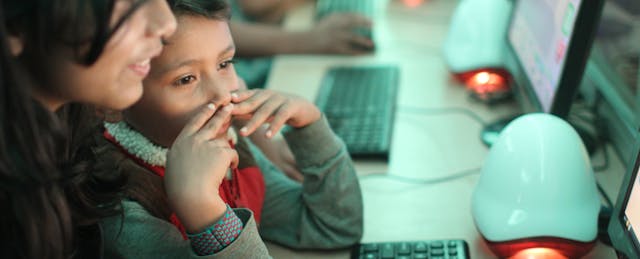Meet Lara. She’s fourteen. Her phone alarm wakes her up with the tune of her favorite song from Olivia Rodrigo. After hitting snooze a few times, she jumps out of bed and checks TikTok and Insta to find out what’s trending before getting ready for school. At the breakfast table, she looks at her calendar for the day. Phew! She barely submitted the essay that was due in English class. It was cool that Ms. Bada had them critique their ChatGPT-designed essays. It's way more interesting than just writing about Homer’s The Odyssey. Coach Gonzalez just messaged the dance team to bring their new uniforms to practice this afternoon. After classes, she checks her online fanart message board. She’s been sharing her art for the past couple of years and got a paying gig to draw some of her favorite characters. Lara doesn’t know what she would do if she didn’t have her phone; everything is right at her fingertips. How do people live without it?!
Meet Maria. She’s also fourteen. She starts the day by checking in on her two younger brothers. She makes breakfast for them, helping her grandparents, who she has lived with since she was a toddler. She helps feed some of their livestock before walking to school. It takes about half an hour to make the trek. She did her best to complete her homework last night, but it’s harder to work during the fall semester when the sun sets so early, and she gets home from school just at dusk. Maria’s home has intermittent electricity, and evenings are a challenge for her as she tries to do things with limited sunlight. Since the pandemic, her school has been more into technology and computers, which is fine for her at school, but what does that mean for her when school is out? She can’t be at school all day; she needs to be around to help her family at home. With no computer at home, inconsistent electricity and a smartphone that she shares with her family, some days, it’s a fight to use the phone to check in on assignments. She’s really into manga art and was gifted an artist’s pad by one of her favorite teachers, who has been encouraging her passion. Maria’s been looking for a means to further develop her artistic skills but is clueless about what’s out there.
Both Lara and Maria are in their first year of high school. They both have visions of being an artist. They both look for ways to hone their skills. They’re both teenage girls. Digital access creates two very different lives and opportunities for each learner. For many of us, when we read their stories, we assume that they live worlds apart. The reality is that these two stories come from conversations and interviews with educators, caregivers and students in the United States from the Southwest to the East Coast with statistics that back up these personal narratives.

How do we change the narrative?
The digital divide is not merely anecdotal but a pervasive issue affecting countless learners. Bridging this gap is a complex task that demands comprehensive strategies. In 2021, the Biden Administration established the Broadband Equity, Access and Deployment Program (BEAD) and the Digital Equity Act (DEA) to address the widening digital divide that the Covid pandemic exposed. With over 48 billion dollars earmarked toward internet connectivity and infrastructure needs across all 50 states and territories, state leadership was tasked to build local and regional task forces to develop a five-year plan for addressing the gaps in hopes of reaching 5 million disconnected homes. At the Pew Broadband Summit held in Cleveland, Ohio, in June 2022, as questions arose regarding the reality of the digital divide, local leaders in Cleveland spoke to the on-the-ground efforts of connectivity that had started as early as 2000. The Assistant Secretary of Commerce for Communications and Information and Head of NTIA, Alan Davidson, admitted that a goal to ensure broadband for all Americans was more likely in six to ten years, a timeline nearly five years longer than the project plan being devised by state governments. So, what does all this mean for learners like Maria? How do we ensure that Maria and others like her don’t have to wait ten years to engage in the digital world?
The way we engage learners digitally has to be equitable. Digital equity thinks of access beyond mainstream solutions and meets learners and their communities where they are, providing supports and solutions that complement their current realities. For example, for teenagers like Maria, being able to complete homework at home would require two things: access to a device at home and access to a device that contains all the learning resources and apps they would need to do the activity without the need for consistent and reliable internet connectivity. Opportunities to access free or affordable devices are needed to solve the first requirement. Organizations like Digitunity, with a network of computer refurbishers across the country, and the Endless Laptop, an affordable laptop program by the Endless OS Foundation, ensure that families can receive their first home laptop without it being a financial burden. With the second requirement, the right device is critical. The device's apps and content are key to building advanced digital skills. Unfortunately, these resources are typically not free and are usually online. The Open Source community noticed this dissonance and created openly available apps like LibreOffice, Blender and GIMP in an effort to democratize access. The Endless OS Foundation leveraged this response by developing an operating system that supports all these openly available tools along with a curated library of K-12 learning resources, in collaboration with open-source aligned nonprofits like Kiwix and Learning Equality, that can be used with or without the internet.
It takes a village: Ensuring digital access requires an ecosystem approach. Federal, state and local government funding and policy are required to help design the needle that we move, but the colloquial “third sector” provides the forward thrust. Philanthropy, in collaboration with nonprofits, is essential to ensure digital access. Thinking of philanthropic giving as a community investment by employing a holistic approach to digital equity is what organizations like Connect Humanity have been doing to not just move the needle but redesign a tool that is stronger and more sustainable than the needle. The Information Equity Initiative (IEI) is looking at digital access through a tried and true method, the television broadcast signal, thereby building partnerships with entities that we might not have previously considered as players in the ecosystem. As numerous organizations collaborate to form collective partnerships, it is imperative that all stakeholders be actively included in discussions to actualize universal digital access.



